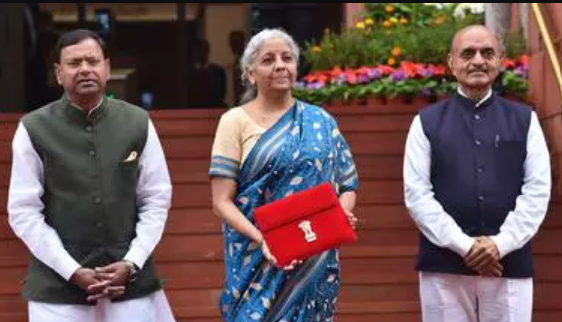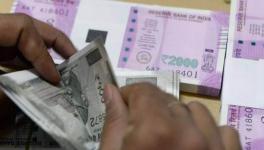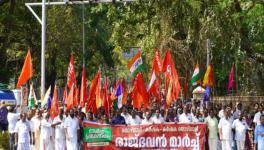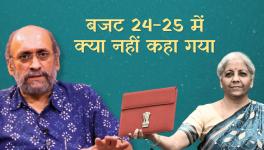Interim Budget Hides the ‘Truth’ of Modi Years

Image for representational purpose. Credit: The Hindu Business Line
The Bharatiya Janata Party (BJP) government holds that truth is what (Prime Minister Narendra) Modi says; if evidence points otherwise, then evidence must be wrong and should be suppressed.
Modi says that India never had it so good as during the last decade of his government; but since official statistics contradict him, the statistics must be wrong and the statistical system must be changed. In this manner one of the finest statistical systems of the Global South, built with great effort and care, is being demolished by this government.
The National Sample Survey (NSS) that PC Mahalanobis had set up has been abandoned when it comes to collecting consumer expenditure data, because the 2017-18 Survey showed, compared with 2011-12, a disastrous fall in real terms, in per capita rural consumption of all goods and services. (Real per capita spending on food had been declining from much earlier).
Likewise, the Census, which had been going on for decades, even before Independence, is abandoned lest it expose the hollowness of Modi’s claims.
Similarly, the basic ILO (International Labour Organisation) definition that unpaid work should not be counted as employment has been abandoned in a brazen attempt to obscure the current unemployment crisis.
In fact, let alone unpaid work, even all paid work should not be counted as employment. During the Great Depression of the 1930s, for instance, many unemployed persons in Britain set themselves up by the roadside as shoe-shiners. They were obviously not shining customers’ shoes without payment, but if they were counted as employed, then the magnitude of unemployment would have appeared to be minimal even during that period of unprecedented crisis. The term “disguised unemployment” was devised to reckon with all such cases. But that was in a society that took its crisis seriously, which alas is not the case in contemporary India.
If Modi’s self-glorifying pronouncements are taken to be the truth, then, not surprisingly, the Union budget becomes merely an exercise in replicating what has gone on in the past. The fact that it would actually aggravate unemployment and the distress of the working people, and increase the grotesque inequality that prevails in the country, would scarcely be acknowledged by the government and its cheerleaders in the media, since the very existence of these problems is denied by the “leader”. The entire exercise of the interim budget presented by Finance Minister Nirmala Sitharaman to Parliament on February 1 confirms this.
Consider the Finance Minister’s speech. She made the bizarre pronouncement that the average real income in the country had gone up by 50%, presumably over the last decade. But this refers only to the per capita income, not to the incomes of the bulk of the population; and to have quoted only this as evidence of national economic well-being shows dishonesty.
The fact that between 2011-12 and 2017-18, there was an increase in nutritional poverty in the country, especially in rural India, is indubitable. The estimated percentage of the rural population unable to access 2,200 calories per person per day (the “norm” earlier used in practice by the Planning Commission to define rural poverty) increased from 68 to over 80! It cannot, therefore, be argued that the bulk of the people of the country were becoming better off during these years. But the point is: what has been happening since then?
We no longer have, as already mentioned, the quinquennial NSS data on consumer expenditure. We do have, however, some other data to fall back upon; and there are two other crucial bits of evidence which many have been using. One is that over the past five years, rural real wages, whether in agriculture or non-agricultural activities, have shown negative growth; and the indications are that the same is true even of urban real wages.
In fact, the latest Periodic Labour Force Survey shows that the average regular monthly real wages, for the country as a whole, including urban and rural areas, have fallen by as much as 20% between 2017-18 and 2022-23! The decline in real wages since 2017-18, therefore, is absolutely indubitable.
The other evidence is that unemployment today is far more serious than at any time since Independence. The Centre for Monitoring the Indian Economy (CMIE) shows that total employment has hardly registered any absolute increase over the past five years. With real wages declining and employment stagnant, the per capita real income of the population engaged as labourers must have actually declined.
The real per capita incomes of the peasants and of labourers would hardly be moving in opposite directions. For, if peasants’ incomes rise, then that also increases the demand for labour, resulting in greater employment opportunities and also higher real wages for the labourers. It follows, therefore, that the per capita real income of the entire working people, consisting of agricultural and non-agricultural labourers and peasants and petty producers, must have fallen over the past five years.
Since the working people constitute the overwhelming majority of the country’s population, the conclusion is inescapable that the majority of the country’s population have experienced a worsening of their living conditions over the past five years.
This, together with the fact noted earlier that between 2011-12 and 2017-18 there had been, according to NSS consumer expenditure data, a decline in real spending by the majority of the population, would suggest that the Modi years as a whole have seen a worsening of the living conditions of the majority of the population.
It is this fact which also explains why private investment has been stagnant during the Modi years, notwithstanding the ruling BJP’s solicitude for big capitalists, especially the handpicked crony capitalists. Indeed, it is not just private non-corporate investment which has stagnated or declined; its stagnation after all should cause no surprise, since this sector has suffered heavy blows in the form of demonetisation, GST (goods and services tax) and the draconian lockdown in the wake of the pandemic.
Even corporate investment has stagnated during the Modi years, despite the fact that corporate post-tax profits have soared. This only shows that corporate investment responds to the growth of the market, rather than to profits at its disposal.
Of course, the government would argue, as indeed the Finance Minister did in her Budget speech, that it has been raising capital expenditure in successive budgets, and that this fact itself should expand, directly or indirectly, the size of markets for the private capitalists, generating greater investment by them. The problem, however, is that a good deal of the demand created by such capital expenditure “leaks” out abroad, so that its contribution toward expanding the domestic market is very limited.
And, much the same can be said for the other strand of the government’s “economic strategy”, which is to make public sector banks give large loans to private capitalists, including crony capitalists, to undertake investment in the “infrastructure” sector. This, by saddling the banks with non-performing assets, shifts the risks of investment from the private capitalists onto public sector banks. Even this way of reviving the economy, however, suffers from the same problem: it cannot revive the economy because a good deal of demand generated by it “leaks out” abroad.
If the Budget had not been constrained by “truth” as propounded by Modi, but had shown even an iota of concern for the real condition of the people, its strategy would have been to improve their living standard in one of two possible ways-- by increasing transfers to them, or by statutorily raising the level of (minimum) wages in the economy.
Such a strategy would have killed several birds with one stone: it would have been directly beneficial for the people, which is desirable in itself; in addition, it would also have stimulated the economy by raising private investment via an expansion of the domestic market.
Such a strategy, however, has been eschewed. Subsidies on food, fertilisers and fuel have been reduced from Rs 4.13 lakh crore (Revised Estimates) in the current year to Rs 3.81 lakh crore in 2024-25. And the expenditure on MGNREGS (the rural job guarantee scheme) has been kept at Rs 86,000 crore, roughly where it was in 2023-24 (RE).
This parsimony has, not surprisingly, been hailed in the loyal media as representing a wholesome preference for “fiscal prudence” over “populism”; and the government’s own narrative is that with “fiscal prudence” India will be able to draw a lot of foreign investment that would push up its growth rate.
But the irony is that despite such commitment to “fiscal prudence”, India’s international “credit rating” remains abysmal: a rung below Indonesia, two rungs below Thailand, and merely one rung above “junk bond” status! International finance capital, in short, is not too impressed with such “fiscal prudence”.
Get the latest reports & analysis with people's perspective on Protests, movements & deep analytical videos, discussions of the current affairs in your Telegram app. Subscribe to NewsClick's Telegram channel & get Real-Time updates on stories, as they get published on our website.
























